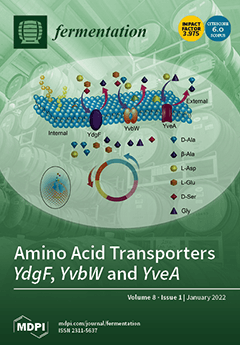The objective of the research was to evaluate the different levels of
Mitragyna speciosa Korth leaves powder (MSLP) added to rations with 60:40 or 40:60 roughage to a concentrate (R:C ratio) on in vitro nutrient digestibility, rumen fermentation characteristics, microbial population, and methane
[...] Read more.
The objective of the research was to evaluate the different levels of
Mitragyna speciosa Korth leaves powder (MSLP) added to rations with 60:40 or 40:60 roughage to a concentrate (R:C ratio) on in vitro nutrient digestibility, rumen fermentation characteristics, microbial population, and methane (CH
4) production. The treatments were arranged according to a 2 × 8 factorial arrangement in a completely randomized design. The two factors contain the R:C ratio (60:40 and 40:60) and the levels of MSLP addition (0, 1, 2, 3, 4, 5, 6, and 7% of the total substrate). There was no interaction between the R:C ratio and MSLP supplementation on gas production kinetics, ammonia nitrogen (NH
3-N), and microbial populations. The gas production rate constant for the insoluble fraction (c) was increased by the R:C ratio at (40:60), whilst there was no difference obtained among treatments for cumulative gas production, whilst the gas production rate constant for the insoluble fraction (c) was increased by the R:C ratio at 40:60. The concentration of NH
3-N was influenced by the R:C ratio and MSLP addition both at 4 and 8 h after incubation. In vitro dry matter degradability (IVDMD) and organic matter degradability (IVOMD) were significantly improved by the R:C ratio and supplementation of MSLP at 12 h. Increasing the R:C ratio and MSLP concentrations increased total volatile fatty acid (VFA) and propionic acid (C
3) concentrations while decreasing acetic acid (C
2) and butyric acid (C
4) concentrations; thus, the C
2:C
3 ratio was reduced. MSLP addition reduced protozoa and methanogen populations (
p < 0.05). The calculated CH
4 production was decreased (
p < 0.05) by the R:C ratios at 40:60 and supplementation of MSLP. Finally, the addition of MSLP as a phytonutrient may improve nutrient degradability and rumen fermentation properties while decreasing protozoa, methanogen population, and CH
4 production.
Full article





